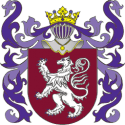To describe in proper heraldic language and colors all that belongs to coats of arms. To ensure that the pictures people draw after reading the descriptions are accurate and reasonably alike, blazons follow a set of rules:
The first thing the blazon describes is the tincture of the field. In some cases of “landscape heraldry” all or part of the field is some sort of landscape.
Next the blazon describes the placement and tinctures of the different charges on the shield. The charges are described from the shield’s top to the base and from dexter to sinister, defined from the shield-bearer’s point of view, not the observer’s.
A heraldic picture is called an emblazon. Emblazons are visual manifestations of heraldic insignia, typically displayed on shields or flags. Because emblazons are awkward to work with, heraldry uses a specialized jargon called blazon to describe shields and flags. Persons skilled in heraldry can discuss shields entirely in blazon, without ever drawing the emblazons. As a noun, the word “blazon” is also used to refer to the heraldic description of a shield or flag.
The great advantage of blazon over plain English is that blazon terms are defined more precisely than English ones. As a result, one can describe a shield more accurately and in fewer words with blazon than one can in plain English.
The distinction between blazon and emblazon is an important one, since there is not a one-to-one correspondence between blazons and emblazons. In many cases, a particular emblazon can be described in heraldic language in more than one way. And no two heraldic artists will draw a given blazon in exactly the same way. But for well-designed heraldry, the blazon captures the important features of the emblazon, and, given a blazon, a trained heraldic artist should be able to produce a reasonable facsimile of the original emblazon.
